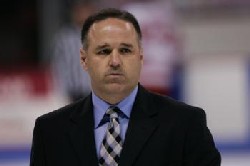One of the brightest lights of the early hockey season hasn’t been the play of one team or one player. Instead, it’s been the collective performance of two teams in one region in Massachusetts known as the Merrimack Valley, home to the Massachusetts-Lowell River Hawks and the Merrimack Warriors.
Two teams lacking splendor in recent years, Lowell is off to a 3-1-0 start and is ranked ninth in the latest USCHO.com/CBS College Sports poll, while Merrimack is 4-2-0 and has posted wins in its first four home games for the first time since joining Hockey East in 1989.
The thread that links these two clubs is the Merrimack Valley, a bi-state region that runs across the northeastern portion of Massachusetts and into southern New Hampshire, which was once one of the most vibrant areas for textile manufacturing in the United States. During the 1800s, the region, spurred by the Merrimack River, which runs from Franklin, N.H., and empties into the Atlantic Ocean in Newburyport, Mass., was the epicenter of business.
After the textile industry left, technology engulfed the region in the 1970s, with Wang Laboratories, one of the first major computer manufacturers, locating their headquarters in Lowell, Mass.
At the same time, the area’s two largest colleges — Lowell and Merrimack — were emerging as Division II college hockey powerhouses. The schools combined for four national championships — three for Lowell and one for Merrimack. The sport was booming in the region and, in the middle part of the 1980s, both schools elevated their programs to the Division I level, eventually becoming members of Hockey East.
Now in greener pastures, each school faced their own challenges in the early days of Division I. Merrimack made the NCAA tournament as an independent team in 1988, but since moving from independent to a Hockey East member in 1989, the team hasn’t posted a 20-win season.

Lowell was also part of the 1988 NCAA tournament field and had a bit more modest success in the mid-90s when then-coach Bruce Crowder led the team to within a game of the Frozen Four in 1994 and 1996.
Crowder left Lowell after the 1996 season. Wang Corporation left the city a year later.
And it could be argued that the region hasn’t seen many bright lights since.
Since 1996, Lowell has posted a 197-235-45 record. Merrimack’s is worse, a paltry 133-284-47. Neither team has reached an NCAA tournament. Lowell’s best finish in Hockey East was fourth in 2002; Merrimack was fifth in 1997.
To say that there was a sudden drop in interest in college hockey in the Merrimack Valley would be an understatement.
For both schools, the timing of this slump was horrible.
In January 1998, Lowell moved from its humble, 3,400-seat home at Tully Forum to the brilliant, state-of-the-art Tsongas Arena. The move seemed like a sensible one at the time as it would move the team from a rink located seven miles from the campus to the newest building in the league now just steps from the residence halls. But Lowell struggled to fill the Tully after Crowder’s departure, and adding 3,100 seats in its new arena would make even decent-sized crowds at the old barn seem like barren desert at the Tsongas.

Down the road at Merrimack, continued struggles on the ice led to dwindling crowds in the stands. The school attempted to renovate what was then called the Volpe Complex (now referred to as Lawler Arena) but ran out of money in the middle, leaving new locker rooms for the Merrimack players and limited private seating for select alums the only highlights in an otherwise dingy building.
Hitting Rock Bottom
On the ice, the 2006-07 season was disastrous for both teams. Lowell posted an 8-21-7 record, finishing in ninth place in Hockey East, while Merrimack “one-upped” the River Hawks in the dismal department, posting just three wins in a 3-27-4 last-place campaign.
Merrimack’s administration never showed any signs of wavering in its support for head coach Mark Dennehy, now having finished his second season behind the bench. But many in the college hockey world turned their noses up at the Warriors and online chat rooms and message boards called for the program to demote itself to a lesser conference.
At Lowell, the dissension was worse. While the campus supported the program 100 percent, rumors began spreading that the UMass system was less than enthusiastic to have two Division I hockey programs competing in the same conference. What was worse was Lowell’s sister school, UMass (in Amherst, Mass.) made its first trip to the NCAA tournament in that same season, upsetting Clarkson and coming just a game short of the Frozen Four.
Troubles for the River Hawks grew to a head that summer when then-Chairman of the Board of Trustees for the UMass system, Stephen Tocco, formed a committee to explore dissolving the Lowell program.
Speculation of the demise was crushing Lowell coach’s Blaise MacDonald’s recruiting efforts and making the end for this once-proud program seem imminent. Only a renegotiation with the city of Lowell on the terms of the lease at Tsongas Arena would put the program on solid ground financially. And reports of initial conversations didn’t seem positive.
Administration Changes Lead to Rebirths
Lowell’s hopes to save the program took a turn for to better in June 2007 when the city of Lowell reached an agreement with the university on lease terms. The financial impact to the university was lessened by the new deal and the school was able to have more control of how the building looked each game night and had a better pick of dates on which to play home games.
Shortly thereafter, U.S. Rep. Marty Meehan, a longtime supporter of the hockey team at Lowell, announced that he was stepping down from his seat in Washington to take over the job as Chancellor at UMass-Lowell. Meehan immediately promised support to the program — both personally and financially.
The Tsongas Arena immediately was transformed from a run-of-the-mill building to one that bled Lowell tradition. Banners lined walls, life-size images of current players accented every pillar. For the first time since the team moved into the building, Tsongas Arena looked and felt like the home of the UMass-Lowell River Hawks.
Not inconsequentially, the on-ice product improved. Last season, Lowell advanced to the Hockey East title game for the first time since 1994 and only the second time in program history. Though it ended up on the wrong end of a 1-0 decision against eventual national champion Boston University, the fact that the team returned many of the top players for the 2009-10 campaign left plenty of positive speculation heading into the offseason.
Up the river in North Andover, an internal shakeup of the athletic department at Merrimack also brought with it positive vibes. Glenn Hoffman, a former associate athletic director at Niagara, was hired to fill the vacant athletic director position, one that had remained empty since Sean Frazier left the school in 2007. (In the interim, local businessman Joe Iarrobino, who also served as interim AD in 2005 after Chris Serino’s departure, ran the day-to-day operations of the athletic program.)
Immediately, Hoffman set the wheels in motion to inject a positive stimulus to men’s ice hockey. Extended marketing to students, the addition of a hockey pep band and a revitalized capital campaign that will fund the completion of renovations at Lawler Arena gave the program a positive boost.
The change was well timed with what Dennehy feels is a changed hockey team. A 4-0-0 start at home this season shows that his hunch might just be right.
Shift in Power?
So how will these sudden changes at the Merrimack Valley’s premier college athletic programs impact things on the ice? Early indications are positive.
Lowell was selected second in the preseason Hockey East coaches’ poll, the highest in the school’s history. This week’s No. 9 national ranking is the highest the school has achieved this early in the season.
Last weekend, the team had an opening night crowd of 5,619 and followed that the next night with 4,049, a major step up from the 1,800 or so that occupied Tsongas Arena most nights just a few years ago.
On Saturday, the school inducted its first Hockey Hall of Honor class in an attempt to draw ties between the success of the past, the goals of the present and the hopes for the future.
“We’ve got a tremendous legacy that we’re very proud of with Lowell hockey,” MacDonald said. “We’re working hard to try to come together as one.
“We had a really nice crowd here [Friday] and really good energy in the building [Saturday].
“[The alumni] were all talking about high expectations for our team and it was nice to get a win for them.
“Those teams [of the ’70s] and this [year’s] team here, there’s no level of entitlement. We have to work for everything we get and that’s the fiber that we share.”
For Merrimack, the expectations of pundits might not be the same as their Merrimack Valley brethren. That, though, doesn’t lower what the team hopes to accomplish. Dennehy’s club seems positive that it can be a playoff-caliber club. Given the renewed focus of the athletic administration, timing couldn’t be better.
“The student body is excited about Hockey East,” Dennehy said. “The best marketing job is when the marketing coincides with a better product. We’ve got a better product now.
“They’re doing a better job on the marketing side and we’re doing a better job on the ice. Hopefully it’s kismet. I tip my cap to the student body. They’re growing with us.”
With the new dedication on campus, playing well in front of the home crowd has become a No. 1 priority.
“We had a lot of alumni here this weekend, and one of the things I’m going to do is bring some of them back to talk to our team,” Dennehy said. “Back in 1978, back in 1988, back in 1998, they expected to win at home.
“Maybe we don’t have as much of that fabric in our jerseys as other programs in our league but it’s there. You only need a couple of wins to see that multiply. I think that home jersey is going to be tough to play against.”


